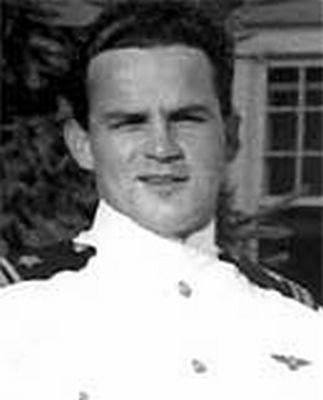Van Haren, Arthur, Jr.
- Date of birth:
- April 9th, 1920 (Superior/Arizona, United States)
- Date of death:
- August 11th, 1992 (Dewey/Arizona, United States)
- Nationality:
- American
Biography
Arthur Van Haren Jr. entered the U.S. Navy at the start of the war. At that time he was still on the University of Arizona in Tuscon. He served with Fighting Squadron 2 (VF-2 "Rippers"). After his pilot training ended in 1942 he was stationed aboard the U.S.S. Hornet (CV-12), flying the Grumman F6F Hellcat.
After the war he took up his study in law and graduated in 1948.
During the Second World War he shot down a total of nine enemy planes. He was also entitled to wear the ribbons for the Presidential Unit Citation, the Navy Unit Recommendation and the Philippine Presidential Unit Citation.
Promotions:
2nd September 1941: Aviation Cadet;
14th March 1942: Ensign;
1st March 1942: Lieutenant (junio grade);
1st April 1944: Lieutenant;
June 1946: Lieutenant-Commander.
Career:
22nd March 1941 - 15th June 1941: Inactive Service;
16thJune 1941 - 15th July 1941: NRAB, Longbeach, California;
16th July 1941 - 3rd September 1941: NAS, Jacksonville, Florida;
4th September 1941: Appointed Aviation Cadet;
?: Fighting Squadron 2 (VF-2 "Rippers"), U.S.S. Hornet (CV-12).
Do you have more information about this person? Inform us!
- Period:
- Second World War (1939-1945)
- Rank:
- Lieutenant
- Unit:
- Fighting Squadron Two (VF-2 "Rippers"), U.S.S. Hornet (CV-12), U.S. Navy
"For distinguishing himself by heroism and extraordinary achievement in aerial flight as pilot of a carrier-based fighter aircraft. On 11 June 1944 in the area of the Mariana Islands as a member of a fighter sweep he assisted in engaging a large number of enemy fighters that attacked his group while rendezvousing. In the ensuing combat, by his skill and courage, he personally destroyed two enemy fighters. During the same operation on 19 June, he led his flight in the interception of and attack upon a large number of enemy fighters approaching our forces. His flight destroyed five enemy planes, of which he personaly accounted for two. His courage and skill were at all times inspiring and in keeping with the highest traditions of the Naval Service."
- Period:
- Second World War (1939-1945)
- Rank:
- Lieutenant
- Unit:
- Fighting Squadron Two (VF-2 "Rippers"), U.S.S. Hornet (CV-12), U.S. Navy
"For distinguishing himself by heroism and extraordinary achievement while participating in aerial flight against enemy airborne forces on 3 July 1944 in the vicinity of the Kazan Islands. He rendered fighter protection to a bombing attack on an enemy air base, to the successful prosecution of which was of extreme importance to the ensuing operations. Despite a disadvantage as to altitude and the fact that his section was attacked by a superior number of enemy planes, he so valiantly conducted himself as to destroy three enemy single engine fighter planes. His courage and skill at all times were in keeping with the highest traditions of the Naval Service."
Second DFC received in the form of a gold star to be worn on the ribbon of the first DFC.
- Period:
- Second World War (1939-1945)
- Rank:
- Lieutenant
- Unit:
- Fighting Squadron Two (VF-2 "Rippers"), U.S.S. Hornet (CV-12), U.S. Navy
"For meritorious achievement in aerial flight as Pilot of a Plane in Air Group TWO, attached to the U.S.S. Hornet, during action against enemy Japanese forces in the First Battle of the Philippine Sea, on June, 1944. Intercepting a hostile scout plane during an extende search mission for units of the Japanese Fleet, Lieutenant VanHaren launched an attack to destroy the enemy craft before it could report our carrier force's position. His skill as an airman resourcefulness and devotion to duty throughout reflect the highest credit upon Lieutenant VanHaren and the United States Naval Service."
- Period:
- Second World War (1939-1945)
- Rank:
- Lieutenant
- Unit:
- Fighting Squadron Two (VF-2 "Rippers"), U.S.S. Hornet (CV-12), U.S. Navy
"For distinguishing himself by meritorious achievement while participating in an aerial flight form a carrier base on 12 September 1944 in the vicinity of the Philippine Islands. As leader of a division of escort fighters he assisted in the protection of the escorted bombers by intercepting an attacking group of enemy fighters and personally destroyed one of them. His leadership and skill were at all times in keeping with the highest traditions of the United States Naval Service."
Second Air Medal received in the form of a golden star to be worn on the ribbon of the first AIr Medal.
- Period:
- Second World War (1939-1945)
- Period:
- Second World War (1939-1945)
- Period:
- Second World War (1939-1945)
Sources
- Photo 1: Familie
- - Arizona's Home Page
- Acepilots.com
- family records and service record









